 |
| A micrometeoriod captured in aerogel |
Several hundred tons of meteoroids enter the Earth's atmosphere each day. Most of these are very small pieces (milligrams) that burn up quickly in the atmosphere and never reach the surface. The following image shows a trail of a meteoroid captured in aerogel exposed to space by the EURECA spacecraft of the European Space Agency.
 |
| A micrometeoriod captured in aerogel |
The track of the meteoroid in this image is only about 0.05 inches long. The meteoroid itself has a diameter of only about 1/1000 of an inch and has come to rest just beyond the narrow end of the track in the upper right (the small white dot).
Some of the larger and sturdier meteoroids survive the frictional heating and strike the Earth's surface; these we call meteorites. Most meteoritic material originates from pieces of asteroids; a smaller amount comes from comets. Thus, meteorites are important scientifically because they tell us about these primordial objects that we believe to be similar in composition to the material from which the Solar System formed.
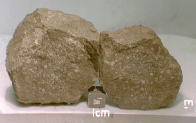 Chondrite (Stony) Meteorite |
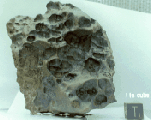 Iron Meteorite |
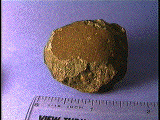 Carbonaceous Chondrite |
The stony meteorites (chondrites) are the most common, iron meteorites are composed largely of iron and nickel, and carbonaceous chondrites are of particular interest because they contain organic compounds and therefore may hold keys to how life developed in the Solar System.
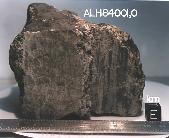 In some cases we believe that we have strong evidence for the exact source of
particular meteorites because their detailed composition is too similar to the
known composition of a parent body to be a coincidence.
Most meteorites come from
asteroids and comets, but
there are a few that are thought to have originated on the Moon, and
a few others that are thought to have come from Mars.
In some cases we believe that we have strong evidence for the exact source of
particular meteorites because their detailed composition is too similar to the
known composition of a parent body to be a coincidence.
Most meteorites come from
asteroids and comets, but
there are a few that are thought to have originated on the Moon, and
a few others that are thought to have come from Mars.
Although this may seem surprising at first, it is not so much so when you consider the violent impacts that all objects in the Solar System have sufferered in the past. It is quite plausible that such impacts could have knocked parts of the Moon and Mars into orbits that would eventually insersect that of the Earth.
The above left figure (Ref) is of a 4.5 billion-year-old rock (meteorite ALH84001), that was discovered in Antartica and that is believed to have been dislodged from Mars by an impact about 16 million years ago and that fell to Earth 13,000 years ago. This meteorite is the center of a major controversy at present because it has been claimed (and disputed) that it contains fossil evidence that may indicate that primitive life existed on Mars more than 3.6 billion years ago (more info). If true, this would be a major scientific discovery, but the jury is still out at the moment.
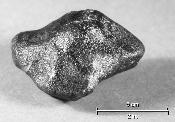 The meteorite shown on the right
(Ref)
was discovered in Western Australia in 1960.
It
is unique because it is made almost entirely of the
mineral pyroxene, and its detailed composition and structure are different from
any rock known for the Earth or the Moon.
This composition suggests strongly that the origin of this meteorite is
the 325-mile diameter asteroid Vesta,
which has the same unique spectral signature for
pyroxene.
The meteorite shown on the right
(Ref)
was discovered in Western Australia in 1960.
It
is unique because it is made almost entirely of the
mineral pyroxene, and its detailed composition and structure are different from
any rock known for the Earth or the Moon.
This composition suggests strongly that the origin of this meteorite is
the 325-mile diameter asteroid Vesta,
which has the same unique spectral signature for
pyroxene.
Other small asteroids observed near Vesta have the same pyroxene signature and are believed to be chips blasted of the surface of Vesta by collisions. This debris extends all the way to a Kirkwood gap that is swept free of asteroids by resonances with Jupiter's orbit. This resonance interaction removes material from the main asteroid belt and hurls it onto a new orbit that can cross Earth's orbit.
It is speculated that this meteorite was torn off Vesta's surface as part of a larger fragment that broke apart in subsequent collisions, ended up in a Kirkwood gap, and was ejected by Jupiter's gravity onto a collision course toward Earth. Hubble Space Telescope observations reveal a giant impact basin on Vesta that may be evidence for the original collision that produced the meteorite (more info).